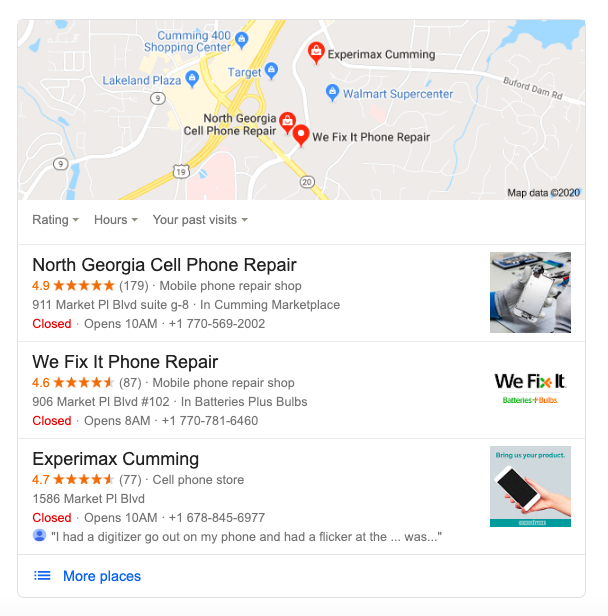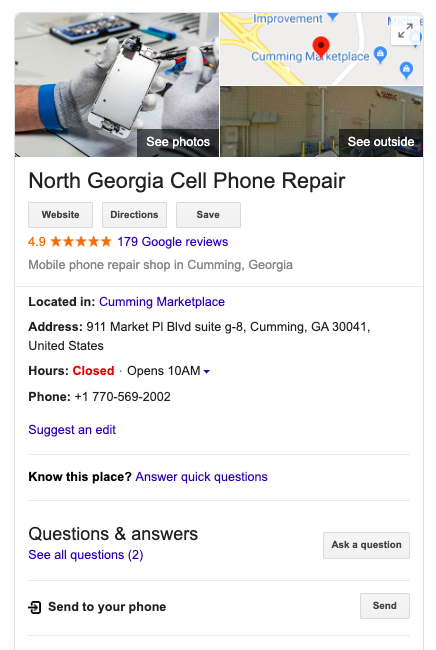December 2021
Local SEO and traditional SEO may sound the same but, in reality, they’re not.
Local SEO involves optimizing your business online so that search engine users can easily find your business in their local area. For example, if you search “local cell phone repair,” “cell phone repair in Atlanta” or “local cell phone repair near me” the results you see are the work of a local SEO strategy.
Local SEO refers to optimizing your website and citations to ensure your business appears in the top results for searches related your products or services. When you consider that 46% of Google searches are local, it’s not hard to understand why Local SEO marketing is so important.
While Google is by far the most used search engine, it isn’t the only one you should pay attention to. It’s important to ensure you are also optimizing for Bing and Yahoo.
So, how does a search engine know your business is local? They all have slightly different parameters, but Google mostly looks for local content, social media activity, links, and citations (which we’ll explain below). Ideally, the goal for any local SEO strategy is to show up on the top 3 rich snippet results in Google.
There are a few different tools and methods you can use to help you get there and stay there. Let’s dive into them!
Local SEO citations are any place your business’s name, address, phone number, and website (NAPW) appear together on the internet. Popular citations include, Google My Business, Bing Places, Apple Maps, Facebook, Yelp, and TripAdvisor. Citations can also include online press coverage or blogs that mention your NAPW. Essentially, if it has your NAPW, it’s a citation.
Because Google wants to guarantee that the information they’re displaying is as accurate as possible, it is very important to ensure that your NAPW information is consistent across all platforms and websites. If Google has any doubt about your information they are less likely to rank you in the top positions.
When it comes to local SEO, Google My Business (GMB) is your best friend. No local SEO strategy is complete without a thorough understanding of GMB.
Essentially, Google My Business is your company’s public profile on Google. This is where you can input all essential information about your business like services, photos, address, phone number, hours of operation, business description, website URL, and industry. If you position well on Google, this is where it pull information for the rich snippets and side bar from. However, note that information like reviews and Q&As are user-generated, and often can't be edited by you.


Considering that 92% of searchers will pick businesses found on the first page of results, it's clear that the information you input into GMB is very important because it shows up all over Google. This also means it’s essential to ensure all of the information on your GMB is as current and correct as possible. Not only does this help Google to rank you higher, but it also makes your business look more trustworthy and attractive to users.
That said, don't put all your eggs in one basket. While Google My Business is extremely important and should ideally be your first step in Local SEO optimization, don't forget about other citations like Bing Places.
Speaking of NAPW, make sure that you’re including this information on your own website. It should be “crawlable” by search engines, meaning search engines can analyze your website and collect the information necessary for positioning. Ensuring that you include your NAPW in the footer and header of your website helps your crawlability.
Another way to localize your website is to include your city, county, region, country, and postal code, throughout your website. This can be in the same spots as your NAPW information, as long as it is natural. If your business has multiple locations, be sure to create individual pages on your website dedicated to each location, and include the relevant local information and citations on those pages.
On many structured citation websites, users who have interacted with your business are given the option to leave a review on their experience. While keeping track of your reviews is good practice for your business in general, it also plays a valuable role in Local SEO.
First, Google My Business keeps track of your overall review score and considers it in its ranking. Second, responding to negative reviews gives you the opportunity to show potential readers how you respond to feedback and to set any future concerns at ease. Always be courteous and thoughtful when leaving a reply to a negative review. In reality, you are responding to the review for the benefit of your future customers, not the person who wrote it.
Inbound links, or backlinks, are links on established websites that lead back to your website. Just like in traditional SEO, inbound links are crucial for establishing relevance and authority on a topic. In terms of Local SEO, backlinks tell Google that you are in fact a legitimate local business.
There are many different ways to get backlinks such as writing guest blog posts on other websites, news and press coverage, influencers and bloggers, sponsorships at popular local events, and getting your website linked on local community websites. The key here is quality over quantity - ensure that your content is always relevant to your buyer persona, and not just fluff.
Having a strong website and landing pages is another key aspect of traditional SEO that carries a lot of weight in Local SEO. A good website not only gives you more domain authority with search engines, but it adds to your business’s trustworthiness. You can optimize your website’s SEO by having a blog, user friendly design, and well-chosen keywords. Clearly explain what your business offers and make sure your customers know how to contact you and locate you.
In addition, ensure that your website is mobile-friendly! 88% of people who search for local businesses on a mobile device either call or visit that business within 24 hours.
Hopefully this Local SEO beginner’s guide helps you build your strategy. By incorporating these tips and tools, you’ll get your business one step closer to landing that number one position! If you want help crafting a strategy that goes beyond these beginner tips, don't hesitate to reach out to us!

Inbound Marketing Strategist at Cyberclick. Helena holds a degree in Advertising and Public Relations from UPF. She specializes in inbound marketing campaigns, digital content creation and web positioning, with experience in CRM management and HubSpot.
Related Content